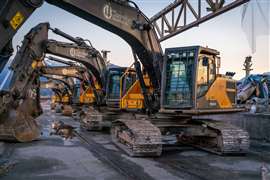Read this article in French German Portuguese Spanish
Demolition excavators: Factory-fitted or aftermarket, which is better?
02 January 2024
Tony den Hoed, Key Accounts Manager for Demolition Equipment at Volvo Construction Equipment, explores the pitfalls of using a machine fitted with aftermarket demolition features, and the benefits of choosing a factory-fitted demolition excavator.
 Adding an aftermarket guarding option to a standard excavator can cost upwards of US$20,000 says Tony. (PHOTO: Volvo)
Adding an aftermarket guarding option to a standard excavator can cost upwards of US$20,000 says Tony. (PHOTO: Volvo)
Wrecking balls are tools of the past. Excavators have the capability to dismantle structures more strategically and safely, and many contractors I talk to view demolition as a growth opportunity for their business.
This leaves them with the decision to either purchase a factory-fitted machine that is specifically suited for demolition or convert a standard excavator with aftermarket fittings.
So how do you decide?
Here are the four primary benefits of a factory-fitted machine and potential pitfalls of outfitting a standard excavator with aftermarket solutions.
Four benefits of factory-fitted demolition excavators
1. Enhanced safety
Let’s start with the most important benefit — safety. If the goal is to outfit the machine with a high-reach boom, there are several nuances between a factory-fitted machine and an aftermarket machine that can greatly impact safety.
Almost every manufacturer that purpose builds their high-reach excavators has a modular joint boom concept, but pins that hold the modular joint to the boom connection can differ. Some use a half hook for the top pin and short pins on the bottom.
However, a well-designed demolition machine uses full-length hydraulic pins. Because they’re hydraulic, an operator can pull them out without leaving the cab. They also are more reliable than shorter-diameter pins.
Converting a standard excavator also requires outfitting the cab with a guarding package, which runs upwards of US$20,000 in the aftermarket. That also involves working with a third party whose package may not be designed for that particular machine and offers limited support.
A factory-fitted demo machine comes with a guarding package and full support for the spare parts by the OEM.
2. Strong, stable platform
A factory-fitted demolition machine has much larger boom cylinders, heavier frames and extra counterweight. They also have hydraulically extendable tracks, which give operators a 360-degree working range. Here are cost estimates to add those features to a standard excavator:
Boom cylinders: US$5,000 each
Counterweights: US$14,000
Hydraulic extensions: US$50,000
3. Visibility and dust control
Two additional considerations are tilting cabs and dust suppression systems. In a factory-fitted machine, the cab will tilt up to 30 degrees, giving operators the best view of the jobsite. Aftermarket tilting cabs will likely cost US$40,000 or more to install.
An aftermarket dust suppression system costs approximately US$10,000 and may not include the different misting options found on a factory-fitted machine.
4. Reduced liability
If there’s a problem with a converted machine, it’s not uncommon for third parties to pass blame to each other.
Also, the more a machine is modified in the aftermarket, the more likely its factory warranties will be voided. It’s best to avoid these scenarios by purchasing a single factory solution covered under one warranty.
The bottom line
While there are options to upgrade a standard excavator to a demolition machine, various components built by multiple manufacturers not only cost a lot of money, but they also come at a detriment to safety, productivity and ease of repair.
Purchasing a factory-fitted machine gives you the best opportunity to make high-reach demolition endeavors successful.
STAY CONNECTED



Receive the information you need when you need it through our world-leading magazines, newsletters and daily briefings.
CONNECT WITH THE TEAM






